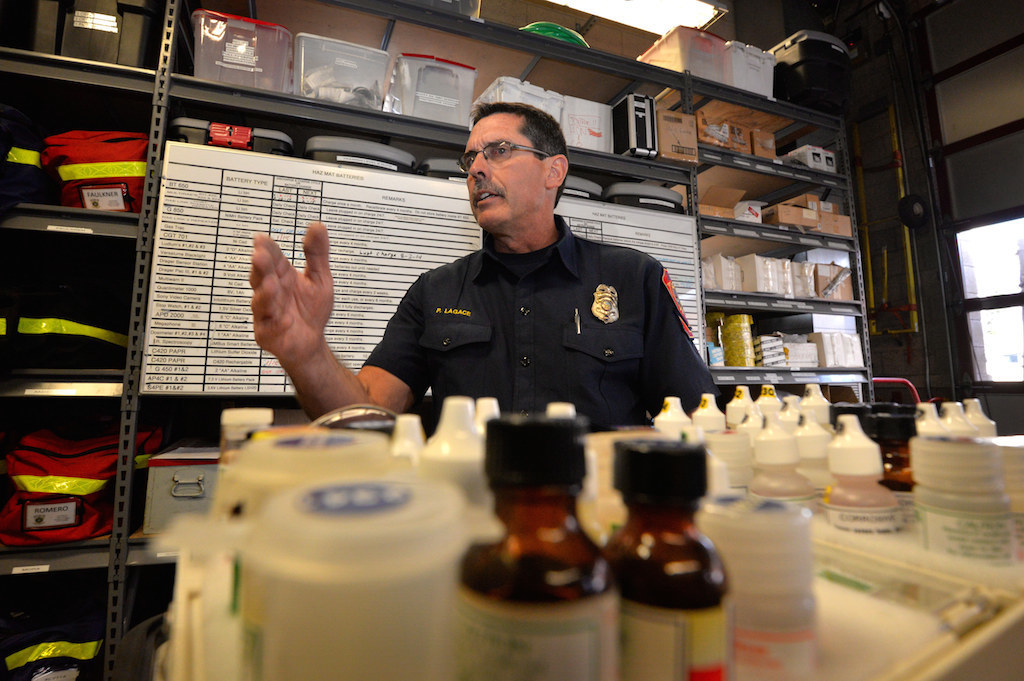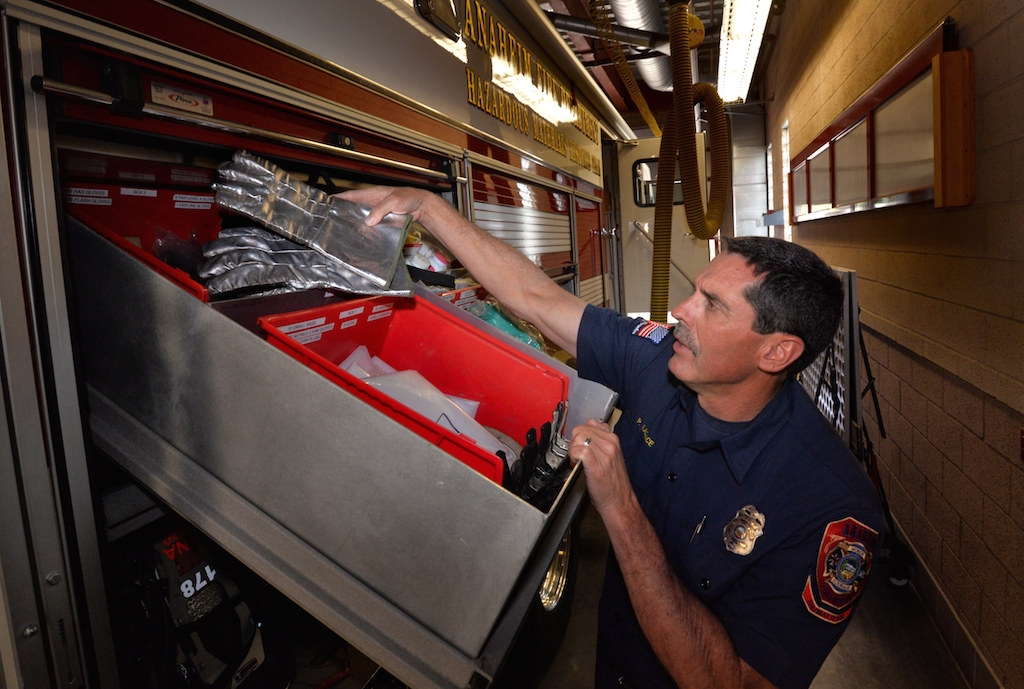Talk about a baptism by fire.
Shortly after it was formed in 1985, the Hazardous Materials Response Team of the then-named Anaheim Fire Department was put to the ultimate test.
On June 22 that year, a fire broke out at a fertilizer warehouse on State College Boulevard, spewing noxious and potentially lethal chemical fumes into the surrounding neighborhoods of Anaheim, as well as portions of Placentia and Fullerton.
For four days, Anaheim firefighters and those from other agencies battled the blaze, which forced the evacuation of nearly 10,000 people. A cleanup overseen by federal officials took 18 days.
Luckily, no one died or was seriously injured.
Thirty years later, Anaheim Fire & Rescue is home to the busiest hazmat team in Orange County — a unit of Hazmat Specialists housed at Fire Station 6, on the west side of the city, who respond to about 300 calls per year.
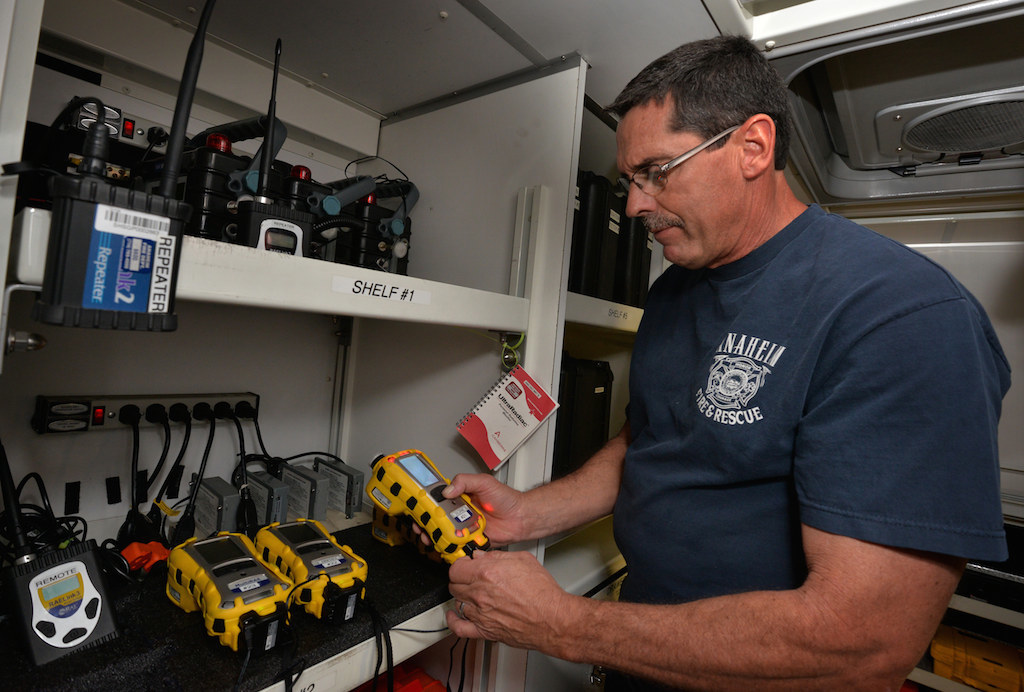
Fire Engineer Paul Lagace shows portable chemical detection devices kept in Station 6’s Hazmat Response Unit, including this one for chlorine.
Photo by Steven Georges/Behind the Badge OC
These firefighters train with two other agencies that have hazmat teams — the Orange County Fire Authority and the Huntington Beach Fire Department. In addition to handling Anaheim calls, the Hazmat Response Team, in partnership with the Huntington Beach Hazmat Team, is contracted to provide hazmat team response services to the cities of Brea, Costa Mesa, Fountain Valley, Fullerton, Garden Grove, Orange and Newport Beach.
One of Station 6’s Hazmat Team Specialists, Fire Engineer Paul Lagace, 52, has been with the team since 1986. Along with Fire Engineer Dave Reed, Lagace is one of only two remaining members of the second graduating class from a special hazmat academy. Firefighter Tom Hogan is the lone remaining graduate of the first class.
During the 1985 fertilizer warehouse blaze — the Fricker Fire, named after the warehouse owner — Lagace was a rookie firefighter assigned to Station 7.
“There’s Mr. Hazmat now,” a Station 6 colleague quips as Lagace pulls an engine into the apparatus bay after returning from a routine call on a recent morning.
A chemistry nut as a kid, Lagace gets to indulge his interest in all things chemical while performing the very serious business of responding to hazmat calls.
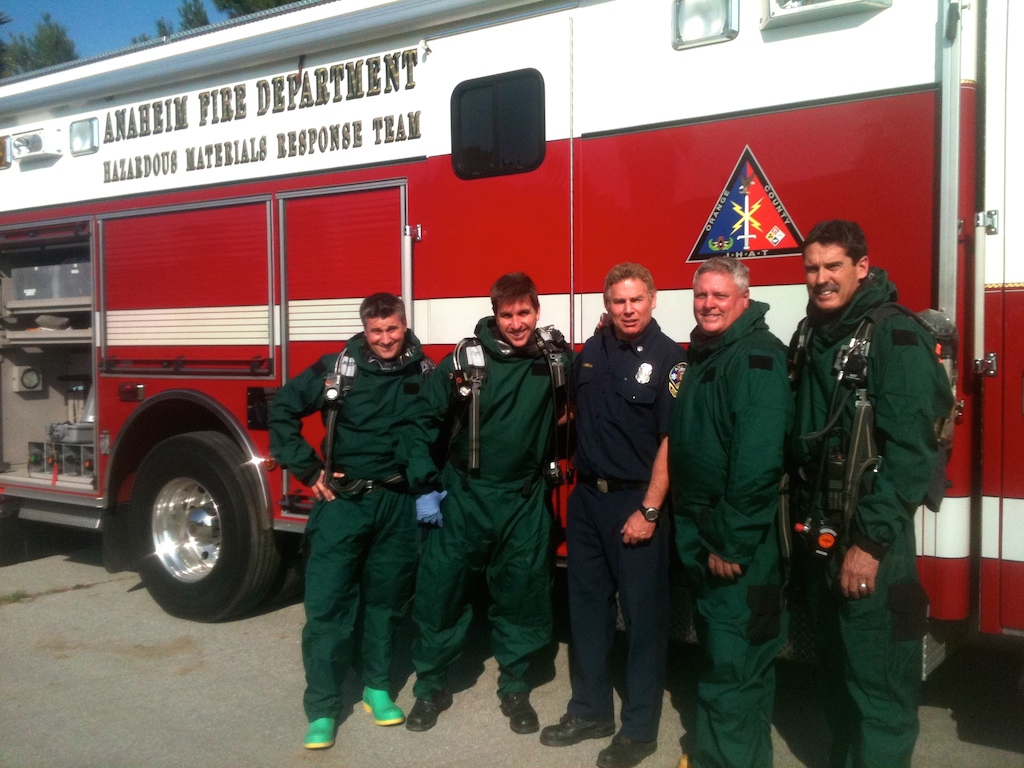
Back in the day: Lagace (far right) with other members of Anaheim Fire & Rescue’s Hazmat Materials Response Team. They are, from left, Robbie Thompson Jr., Bobby Lambert, Dave Ackerman and Wayne Justl. Photo courtesy of Paul Lagace.
“We’re running in while all others are running out,” he says of his job, as well as the jobs of the other Hazmat Specialists housed at the three-story, 14,540-square-foot Station 6.
The Hazmat Specialists at Station 6 are Captains Don Hail, Ralph Moreno, Greg Fox, Dave Ackerman, Aaron Mooney and Brent Faulkner; Engineers (in addition to Lagace) Dave Reed, Jake Anderson, Dave Galaz, Greg Ohara and Kevin Klytta; and Firefighters Wayne Justl, Frankie Mora, Bobby Lambert, Tom Hogan, Robby Thompson Jr., Geoff Moody, Ricky Romero and Mike Patterson.
Every day, seven Hazmat Specialists — two captains, two engineers and three firefighters — are on duty should a call come in requiring the use of a special rig called the Hazmat Response Unit (Station 6 also houses one engine, one truck and a battalion chief, Rusty Coffelt, who is the Hazmat Program Manager).
The hazmat unit, emblazoned with a colorful logo with the slogan “Living in the Hot Zone,” is packed with sophisticated equipment to test and identify hazardous materials, as well as shelves of reference books and detection tools.
Although oil spills, gas leaks, abandoned containers in alleys, manufacturing processes that go bad and unused motor oil are common calls for the hazmat team, over the years the nature of many calls has evolved.
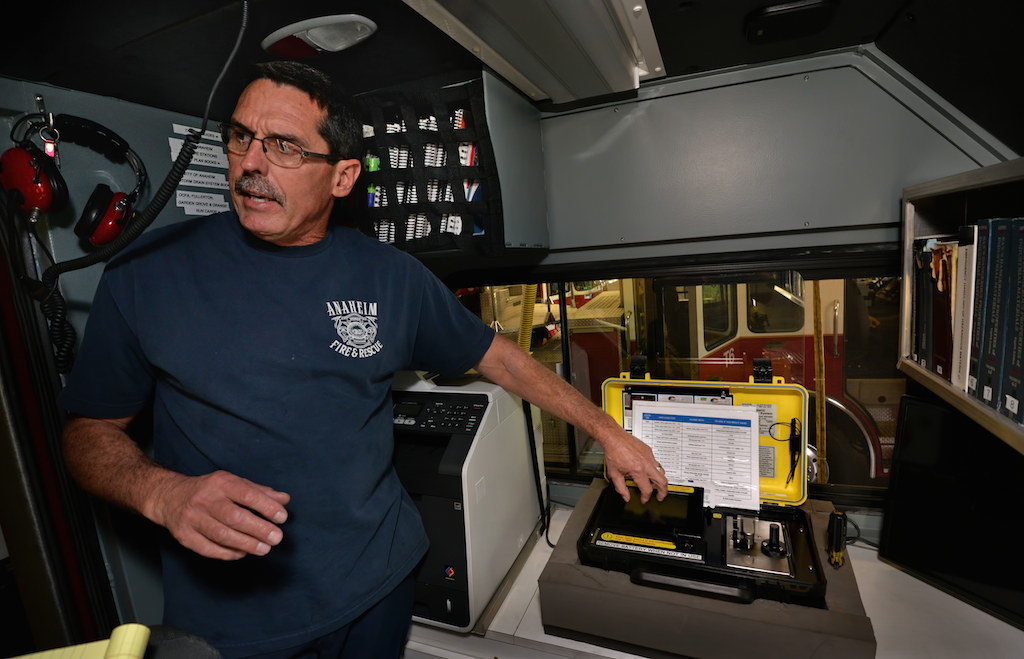
Lagace talks about chemical detection equipment inside Station 6’s Hazmat Response Unit.
Photo by Steven Georges/Behind the Badge OC
Methamphetamine lab-related calls were common in the 1990s, Lagace said.
After the terrorists attacks of 9/11, calls about suspicious white powder (during the anthrax scares) were routine, he said.
Four weeks (160 hours) of intensive training are required for a firefighter to be designated a Hazmat “Technician.” An additional two weeks (80 hours) bumps them up to the level of “Specialist.”
In recent years, Anaheim Fire & Rescue Hazmat Specialists have had to become familiar with chemical and biological weapons. To keep up with these ever-evolving lethal agents, they train with experts from the Army National Guard’s 9th Civil Support Team in Los Alamitos, and FBI Hazmat Response Teams.
The Hazmat Response Unit is packed with sophisticated equipment for hazmat specialists to quickly determine what material or materials they are dealing with. One device, called the SensorIR Machine, is an infrared spectrometer that gives a chemical fingerprint of a liquid or solid.
“A lot of the times,” Lagace said, “we’re trying to figure out what the substance isn’t — such as a flammable gas, a poison or a radiological agent. It’s a process of elimination.”
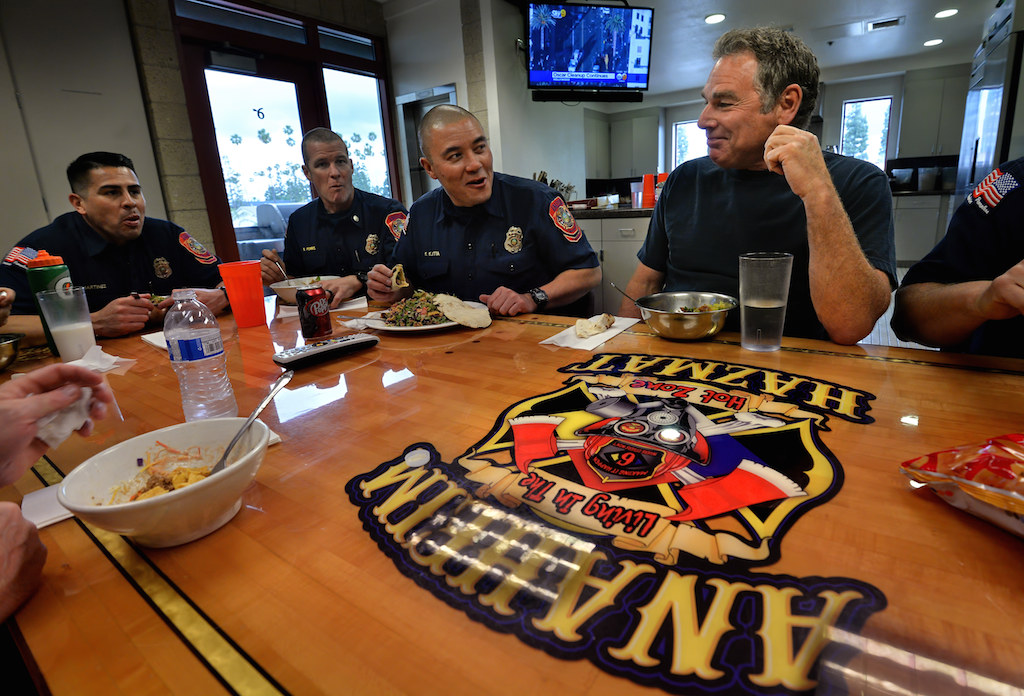
Firefighters from Anaheim Fire and Rescue’s Station 6 have a chance, between calls, to get together for lunch at the station. The table with the Hazmat Materials Response Team’s logo was made from a bowling alley lane and includes a chunk of glass from the fallen World Trade Center in New York City. Photo by Steven Georges/Behind the Badge OC
Anaheim Fire & Rescue’s hazmat unit includes special equipment such as spark-resistant brass tools, inflatable pools for firefighters to decontaminate themselves, and heavy-duty plastic bags for hazmat suits to be sealed inside to be tested later for contamination.
The protective hazmat suits keeps firefighters protected from liquids or gases in a fully encapsulated environment that the user wears with a self-contained breathing apparatus (SCBA) that has one hour of breathing air. On a hot day, the suit can easily reach temperatures in excess of 100 degrees inside.
Because wearing the suit is so taxing on the body, a firefighter is limited to wearing one to two hours a day, in one-hour segments. Hazmat Specialists are weighed and their vital signs are taken before and after they wear the suit.
“You can lose 8 pounds an hour wearing one,” Lagace says.
But when running into potentially lethal situations, the hazmat suits — made of impermeable synthetic rubber — are priceless, Lagace says.
“On those calls,” he says with a smile, “I make sure I dress for the occasion.”

Lagace stands next to the Hazmat Response Team’s logo while talking about the type of calls the crew goes on.
Photo by Steven Georges/Behind the Badge OC
 Behind the Badge
Behind the Badge

